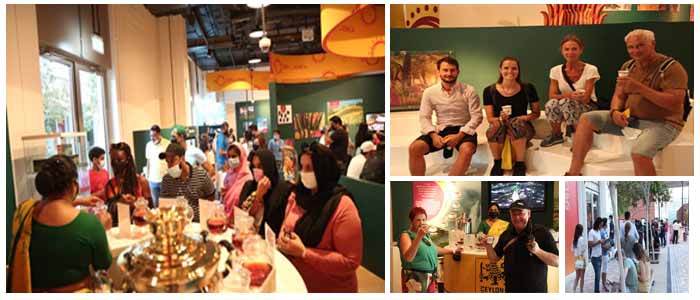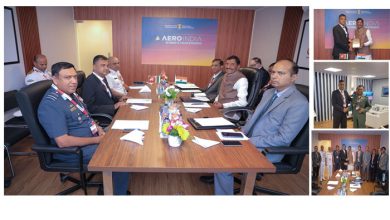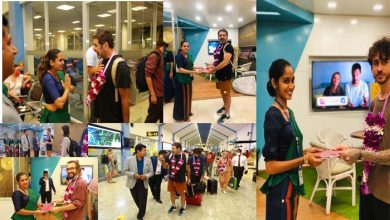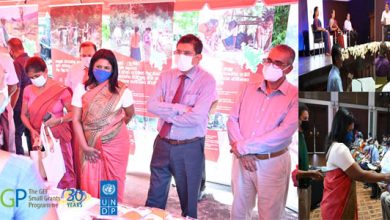Circular Economy, Tourism Value Chain and Sustainable Tourism Development in Sri Lanka
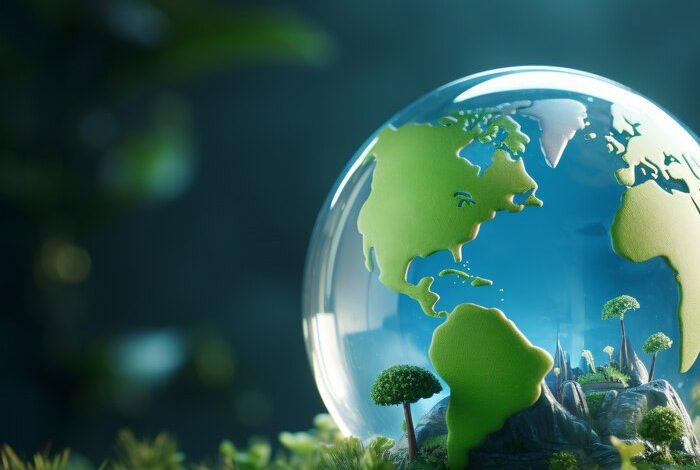

By Prof. DAC Suranga Silva
Professor in Tourism Economics
Coordinator: Sustainable Tourism Unit (UOC-STU),
University of Colombo Emails: drsuranga@econ.cmb.ac.lk; drsuranga3@gmail.com
Global Economy: “Surprisingly Resilient”
Despite the World Economy is “Surprisingly Resilient”, the global economy is still facing significant challenges due to the remaining impact of the COVID-19 pandemic, geopolitical instability, and cyclical economic forces with the projected growth at 3.1% in 2024 and 3.2% in 2025 (IMF-2024).
Recovery of Global Tourism: “Impressively Coming Back Better”
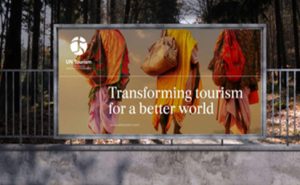 Along with these economic dynamics and challenges, current global tourism development is also influenced from several key factors such as changing travel demands, new dimensions of investments, pro-tourism government policies, shaping with new geopolitical settings while ensuring a strong resilience, sound growth and promising sustainability.
Along with these economic dynamics and challenges, current global tourism development is also influenced from several key factors such as changing travel demands, new dimensions of investments, pro-tourism government policies, shaping with new geopolitical settings while ensuring a strong resilience, sound growth and promising sustainability.
Current Global Tourism Development: “Becoming A Great Trend Setter for New National Records”
The latest UNWTO data shows that international tourism has almost completely recovered from the unprecedented crisis of COVID-19 with many destinations reaching or even exceeding pre-pandemic arrivals and receipts. The growth global tourism continues to outpace the global economy. The Worldwide destinations experienced a notable surge in international tourist arrivals during the third quarter of 2023, marking a 22% increase compared to the same period last year.
Year 2024: “A Historic Year for Global Travel & Tourism Sector”
Revealing the Travel & Tourism’s pivotal role in global economy, the World Travel & Tourism Council (WTTC) forecasts a historic year for the Travel & Tourism sector in 2024, with its global economic contribution projected to reach an unprecedented $11.1 trillion. This figure surpasses previous records by $770 billion, solidifying the sector’s status as a significant global economic force, accounting for One in Every Ten Dollars Worldwide.
As the industry surpasses pre-pandemic levels of prosperity, the WTTC anticipates that 142 out of 185 analyzed countries will achieve national records. The WTTC’s latest Economic Impact Research highlights a sector ripe with opportunities, supporting nearly 348 million jobs globally, an increase of over 13.6 million compared to 2019. In addition, the WTTC highlight that in year 2023, the Travel & Tourism sector created:
- Nearly US$10 trillion into the global economy.
- 1% of global GDP
- Nearly 330 million jobs worldwide.
- 33% increase in international spending
The WTTC is forecasting a promising future for the next decade, characterized by robust growth and unparalleled career opportunities.
- By 2034, the travel and tourism sector will supercharge the global economy with a staggering $16TN, making up 11.4% of the world GDP.
- Setting a job creation juggernaut, providing employment for 449MN people worldwide, representing nearly 12.2% of the global workforce.
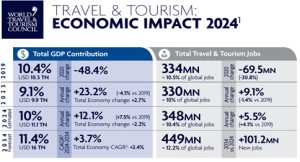 In parallel to the WTTC, the UNWTO clearly highlighted that “international tourism has almost completely recovered from the unprecedented crisis of COVID-19 with many destinations reaching or even exceeding pre-pandemic arrivals and receipts. This is critical for destinations, businesses, and communities where the sector is a major lifeline.” – UNWTO Secretary-General (https://www.unwto.org/news).
In parallel to the WTTC, the UNWTO clearly highlighted that “international tourism has almost completely recovered from the unprecedented crisis of COVID-19 with many destinations reaching or even exceeding pre-pandemic arrivals and receipts. This is critical for destinations, businesses, and communities where the sector is a major lifeline.” – UNWTO Secretary-General (https://www.unwto.org/news).
UN Tourism Confidence Index and Global Tourism Positive Outlook
According to UN Tourism (Former UNWTO) with its tagline of “Bringing the World Closer”, the positive outlook for the sector is reflected through the findings of the latest UN Tourism Confidence Index Survey.
- It revealed that 67% of tourism professionals indicating better or much better prospects for 2024 compared to 2023.
- The unleashing of remaining pent-up demand, increased air connectivity, and a stronger recovery of Asian markets and destinations are expected to underpin a full recovery by the end of 2024.
- Economic and geopolitical challenges continue to pose significant challenges to the sustained recovery of international tourism and confidence levels.
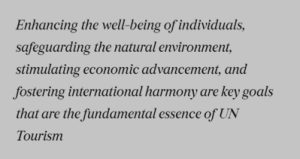
However, UN Tourism identifies through its market survey what factors determining the rapid recovery and beyond the recovery of global tourism.
The economic environment, high transport and accommodation costs, extreme weather events, Geopolitical conflicts and also staff shortages were identified as the key reasons among the other factors.
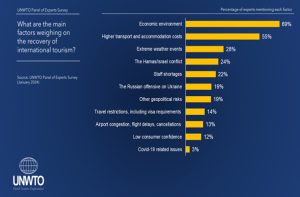
Global Tourism: “Craving Search for New Travel Experiences”
The phenomenon of tourism has become deeply rooted in human behavior, fulfilling our natural inclination for novel experiences. Changes in demand patterns and objectives within tourism have resulted in a wide array of offerings in global tourism products.
The post-COVID adjustments in behavior among global tourists have catalyzed fresh market trends and segmentation within the global tourism industry:
- Shifting from Homogenous to Heterogenous Tourism Demand: “Travelers Desire Variety with Authenticity”
- Adaptation for Climate Change: “Cooler regions becoming more appealing”
- Growing Family and Couple Travels: One of the fastest growth-recovered segments in global tourism
- Luxury Over Economy Travels with Responsible Behaviour: Partly as a result of “Revenge Travels”.
- Wellness & Retreat Tourism: “Wealthier people seeks more healthier travels”.
- Eco-Travel: “Richer people seeks more greener travels”.
- Personalized Tourism: Tailor-made travels through personalized travel motives.
- Cultural Heritage Tourism: Rising interest for authentic cultural experiences.
- Bleisure Travel: Finding a Right combination of business and leisure travel.
- Augmented and Virtual Reality Travel: Modern technology for memorable travel experience.
- Accessible Tourism: Tourism for all
- Inclusive Tourism: No one behind left
- Spiritual Travels: Tranquility for life
- Slow and Solo Travels: Discovering and embracing the journey with memorable experiences
- Sleep Tourism: Health and stress reduction through sleep rejuvenation
Growing such tourism market segments are driven through special interests, memorable & personalized experience, value for travels, responsible travel behavior, sustainable tourism practices and so on.
Sri Lanka Tourism: “Remarkably Coming Back”
Along with the recovery of global economic with increasing discretionary income, global tourism is currently bouncing back showing a significant international tourist traffic. Sri Lanka Tourism has also showing a significant growth by increasing tourist arrivals and tourism income generation.
Source: SLTDA (March 2024)
According to recent statistics of SLTDA,
- Sri Lanka could inflow in tourist arrivals from key markets like India, Russia, the UK, Germany, and China.
- By the end of 2024, international tourist arrivals are expected to surpass 2019 levels.
- Europe and Asia-Pacific’s crucial roles in Sri Lanka’s evolving tourism dynamics. Europe as a regional source market could dominate Sri Lanka’s tourism (58.6% of total arrivals, followed by Asia-Pacific at 34.6%. Increased demand from India, Russia, Germany, the UK, and China boosted the sector.
- Recreational activities were the main reason for tourists to visit Sri Lanka. This reinforced its reputation as a relaxation destination.
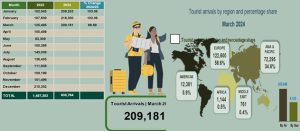
- Visiting friends and relatives in Sri Lanka has become a significant source, more specifically tourist arrivals from Australia (30.2%) Canada (54%) and UK (17.1%) visited on this purpose.
- Additionally, MICE tourism and Business tourism have become attractive segments in Sri Lanka Tourism.
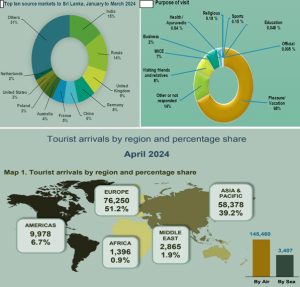
Source: SLTDA (March 2024)
However, for the sustainability of this positive performance in Sri Lanka Tourism, it is crucial and fundamental to understanding and acknowledge the growing global concerns in sustainable tourism application along with the emerging trends of global tourism at present.
Recent Trends in Global Tourism for Sustainability: “Exponential Growth”
According the recent trends and patterns in global tourism, revealed by various organizations (https://www.travelperk.com/blog/sustainable-travel-statistics-trends/), a marked growth in sustainable tourism demand and practices can be identified:
- Sustainable tourism market is estimated at USD 918 billion in 2027 with a CAGR of 9.54% between 2022 to 2027.
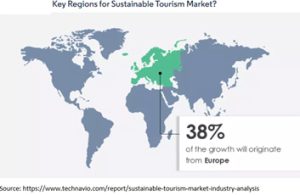
- Searches for “sustainable travel” have increased by 191% from 2020 to 2023
- Gen Z (56%) and millennial (51%) travelers are the most concerned with sustainable travels.
- 77% of travelers aged between 18-29 concern the sustainability impact for their travel decisions.
- 43% of travelers would be willing to pay more for more sustainable travel options.
- 69% of travelers expect their travel expenses need going into the local economy.
- 59% of travelers wish to pay to offset their carbon emissions when they travel.
- 50% of travelers generally choose sustainable travel options to care about the impact of their travels.
- Another 26% say sustainable travel options give them a better travel experience.
- Travelers are willing to pay up to 75% more for an eco-friendly hotel accommodation.
- 73% of travelers are more likely to choose accommodation from the providers who advertise their sustainability practices.
- 65% of travelers would feel better about staying in a particular hotel or accommodation when it maintains sustainable certifications or met certain sustainability requirements.
- 27% of travelers would like the choice to opt out of daily room cleaning in order to reduce water usage.
Furthermore, some other research findings (https://www.avantio.com/blog/sustainable-tourism-statistics/; https://www.technavio.com/report/sustainable-tourism-market-industry-analysis) also revealed that:
- 61% of travelers are interested in ecotourism
- 78% of travelers plan to stay in eco-friendly accommodations
- Many would show their preference for Off-Peak and Authentic Experiences
- 40% of travelers are willing to travel outside peak season,
- 64% consider less popular destinations, signaling a shift towards authentic and sustainable experiences.
- 80% of travelers want to learn about local culture of their destinations,
- 76% seek to reconnect with nature, highlighting a demand for authentic experiences.
- 42% of travelers support local businesses during their travels
- Majority of tourists believe that travel companies must take environmental responsibility when arranging their tour packages
- The key driving factor for the implementation of sustainable tourism practices will be large tourism companies.
Sustainable Tourism and Circular Economy:
“Tourism that takes full account of its current and future economic, social and environmental impacts, addressing the needs of visitors, the industry, the environment and host communities”
-https://www.unwto.org/sustainable-development
UN-Tourism further explains that sustainable tourism principles apply universally across all types of tourism and destinations, encompassing both mass tourism and niche segments, addressing environmental, economic, and socio-cultural aspects, necessitating a balanced approach for long-term sustainability.
Transition from “Linear” to “Circular” Economy
Replacing the Linear Economy, the new paradigm of Circular Economy focuses for a holistic approach aimed at minimizing waste and maximizing resource efficiency under the principles “R”s Practices starting mainly based on 3”R”s (Reduce, Reuse, Recycle) and later higher numbers of “R”s introduction such as 5Rs, 6Rs, 10Rs and so on. All such R concepts ensure the adopting practices of sharing economies and responsible production system through cost savings and resilience building.

A linear tourism economy is a one-way or one-sided model of resource use and waste generation. It involves a straightforward process where resources are extracted, processed, used by tourists, and then disposed of as waste.
This approach often leads to significant environmental impact, resource depletion, and inefficiencies, as it emphasizes short-term gains and profit maximization over long-term sustainability.
In a linear tourism economy, the focus is mainly to maximize the profit through increasing tourist arrivals, tourism revenue without adequately considering the environmental and socio-economic costs, leading to challenges such as over-tourism, pollution, and degradation of natural and cultural assets. In addition, the value added and fair distribution of tourism income are seriously questionable when considering Sri Lanka as a destination.
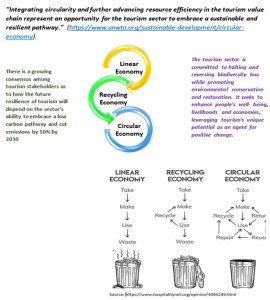
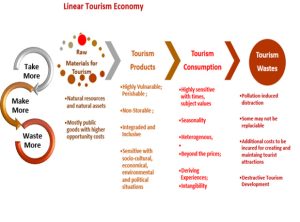
A Circular Tourism Economy is a sustainable approach to tourism development that minimizes waste and optimizes resource use throughout tourism value chain. Inspired by the principles of the circular economy, which seeks to reduce, reuse, recycle, and regenerate resources, tourism circular economy focuses on creating more sustainable tourism practices.
It involves reconsidering how tourism products and services are to be designed, consumed, and disposed while minimizing environmental impact and maximizing socio-economic benefits.
- Key Elements of tourism circular economy include waste reduction, energy efficiency, sustainable sourcing, innovative business models, and community engagement.
- By adopting circular principles, destinations and businesses in tourism industry will contribute to more resilient, environmentally friendly and socio-economically responsible tourism systems
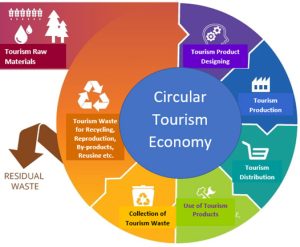
Adjusting Value Chain for Tourism Sustainability in Sri Lanka
UN Tourism defines a Tourism Product as “a combination of tangible and intangible elements, such as natural, cultural and man-made resources, attractions, facilities, services and activities around a specific center of interest which represents the core of the destination marketing mix and creates an overall visitor experience including emotional aspects for the potential customers. A tourism product is priced and sold through distribution channels and it has a life-cycle” (https://www.unwto.org/tourism-development-products).
- The value chain in sustainable tourism expects to provide a holistic framework that can manage the entire process of Delivering Value from Raw Materials to the End Consumers in the tourism industry/sector.
- It should involve in optimizing each stage for efficiency and competitiveness while maintaining sustainability.
- As explained in the previous studies and analyses made on the initial concept developed by Michael Porter (1985) in his publication on “Competitive Advantage: Creating and Sustaining Superior Performance” the tourism value chain includes transportation, accommodation, activities, and services, all contributing to the overall tourism experience and finally the margin of the value chain that is profit of a business operation.
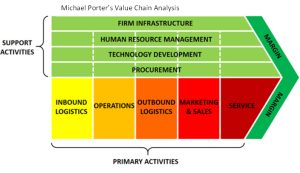
- The same concept has been used for different tourism destinations and countries as a tourism destination in general represents a macro-level value chain.
- It encompasses a broad and interconnected network of stakeholders and activities that collectively create and deliver value to tourists.
- This network includes various sectors such as accommodation, transportation, attractions, dining, and entertainment, each contributing to the overall visitor experience. At the macro level, the destination integrates these diverse elements, facilitating seamless coordination and synergy among service providers, local communities, and governing bodies.
- This holistic approach ensures that the entire value chain—from initial marketing and visitor attraction to on-site experiences and post-visit engagement—functions efficiently, enhancing the destination’s competitiveness and sustainability in the tourism market
- Integrating sustainability principles throughout the tourism value chain to ensure the sustainability of the industry must be prudently carried out.
Sustainable Sri Lanka Tourism: A Way Forward
All in all, it is clearly emphasized that redesigning and rebuilding Sri Lanka Tourism must be centralized with the principles of Circular Economy with Sustainable Tourism Value Chain Process.
- The prevailing business operational system, geared with profit maximization characterized by unrestricted resource utilization, unregulated production and the generation of extensive environmental waste is to be replaced through more specifically through an evolutionary and well inclusive approach.
- Sustainability of tourism businesses in Sri Lanka must be ensured through their viability, bearability and equability within an endurable profitability framework under the rejuvenated tourism product life cycle, careful utilization of natural and local resources.
- Overcoming the key challenges of achieving sustainability of Sri Lanka Tourism such as the limited consumer & stakeholders’ awareness, irresponsible tourism operational practices, unsustainable consumption and resource utilization patterns, unbridled profit maximization, destructive competition and existing regulatory hurdles must be effectively addressed to ensure a transition of Sri Lanka Tourism toward for more sustainable circular tourism economic model.
- In line with the well-known “Hartwick Rule”, the sustainable use of renewable resources for tourism industry requires that consumption should not be greater than the rate at which resources regenerate. In this context, Carrying Capacity Management, new technology application, human resource development and Regenerative kind of tourism development should be promoted.
- It is crucial to prioritize environmental conservation, community involvement, and the development of green infrastructure to achieve sustainable tourism in Sri Lanka.
- Engaging local communities through empowering them in tourism planning, management and operational levels should be ensured.
- Encouraging local sourcing in order to reduce transportation emissions and to support local economies,
- Design tourism products under the application of the key principles of Circular Economy – Longer life cycles of natural resources, Reusing, Recycling, Reproducing, Zero-Waste & Plastic-Free Programmes etc.
- Rationalized and prioritized Investments for sustainable tourism infrastructure development like renewable energy sources, eco-friendly transportation, and waste management systems must be encouraged through Public-Private and Community Partnerships.
- Enhancing the sustainable tourism value chain process through an integrated management, stakeholder collaboration, use of innovative technologies is essential for delivering high-quality experiences.
- Strengthen the coordinating activities across the value chain ensures seamless service delivery, while fostering partnerships between government, private sector, and local communities in order to enhance the overall tourism experience for the tourists.
- Leverage the modern technologies to improve the operational efficiency and customer engagement, providing personalized experiences
- Maintain the required high standards of service and product quality throughout the value chain ensures customer satisfaction by embracing emerging trends in global tourism ensuring Sri Lanka Tourism more forward-thinking, proactive, resilient while making Sri Lanka Tourism sustainable destination in the region.
Selected Key Reference:
- unwto.org/sustainable-development/circular-economy
- wttc.org/Portals/0/Documents/WTTC-Harvard-LearningInsight-CircularEconomy.pdf
- unwto.org/sustainable-development/unwto-international-network-of-sustainable-tourism-observatories/tools-solid-waste-management
- un.org/en/observances/zero-waste-day
- mdpi.com/2071-1050/15/17/13226
- switch-asia.eu/site/assets/files/2460/giz_tourism_value_chains_en.pdf
- wto.org/english/tratop_e/devel_e/a4t_e/global_review13prog_e/tourism_28june.pdf
- undp.org/sites/g/files/zskgke326/files/migration/ks/UNDP_vitia_value-chain_eng_web.pdf


